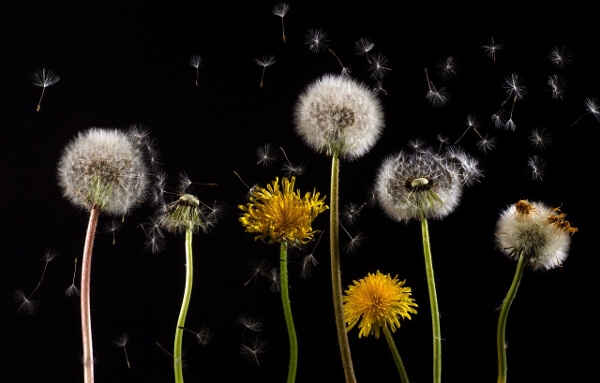
Spring is finally here and so is warmer weather, as well as the urge to open every window to let fresh air inside your home once again. For one in five people in the UK, however, the latter presents a dilemma.
As most hay fever sufferers know, the beginning of each year becomes an internal struggle between the desire to welcome the fresh spring air with open windows and the knowledge that, as soon as you do so, your home will be invaded by sneeze-inducing pollen.
Usually, the longing to dispel stale air wins the battle and your home becomes a minefield of pollen, which patiently floats midair waiting to trigger an allergic response. To help you overcome this predicament, we have compiled a list of ways to eliminate pollen in the house.
Table of Contents
When is allergy season in the UK?
Allergy season has three phases which overlap.
- Tree pollen – from March to May;
- Grass pollen – from May to July;
- Weed pollen – from June to autumn.
A surprising study suggests that some pollen season phases can even start earlier due to the globally rising temperatures. People with allergies may show symptoms even in winter (from January to February).
Also, allergy season may start at different times, depending on where you live. For example, the north of the UK experiences a shorter allergy season that begins later. This region of England also has a lower rate of pollen. Urban areas also have a lower count of pollen, when compared to the countryside. Regions that are far away from the sea tend to have a high pollen rate.
Take good care of the garden
As the majority of hay fever reactions are triggered by grass pollen, it is advisable to keep your lawn short so that it cannot flower and release pollen. If you don’t have the time or your allergies are too severe, contact us to ask about our lawn care service.
Other than this, consider replacing the plants which release pollen into the air with non-flowering alternatives (check out our article “Your guide to an allergy-free garden” for more information). This will allow you to enjoy your garden more during the hay fever season and reduce the amount of pollen that can get transferred into your home.
Set a regular house cleaning schedule
Keeping your home clean and clear of allergens is, sadly, a never-ending process. However, this is the best method to ensure that pollen is kept to a minimum. You can stick to your usual cleaning schedule, but try vacuuming and cleaning the areas around your windows and doors at least twice a week while the hay fever lasts.
If you don’t have the time to vacuum several times a week, why not consider buying a robot vacuum and setting it to roam your home while you are at work each day? Not only will your floor be clean when you get home, but you will also be able to tell all of your friends that you have a robot housekeeper!
Keep windows and doors closed
The easiest way to stop pollen from infiltrating your house is to keep your windows and doors closed as often as possible, especially when the pollen count is at its highest (early morning and evening).
Staying up to date with the pollen forecast will also let you know when it is safe to open all of your windows and bask in the freshness of spring air. Most local and national weather forecasts will include a segment related to the pollen count, but if that’s not the case, you can also check it on the Met Office website.
Install anti-pollen window screens
If you cannot bear to keep your windows and doors closed during this glorious season, another great option is to install anti-pollen window screens. Although these screens can be a bit pricey, they will allow you to experience all of the freshness that spring brings and also keep dust and pollen at bay.
Just remember to clean the screens once a week or every two weeks to remove the dust and pollen buildup trapped in the screen.
Consider removing the carpets
Carpets and rugs are magnets for dirt and pollen. Regardless of whether it is airborne or tracked in via your shoes or clothing, removing pollen from your carpet can be quite difficult, even with regular cleaning.
To avoid all of it, consider removing the carpets and replacing them with hardwood flooring, tiling, linoleum, or laminate flooring. This could be either a permanent solution or a temporary one until the active pollen season is over.
On the other hand, these flooring options are easier to keep clean and pollen will also have a hard time finding a place to hide. If you insist on keeping your home carpeted, however, invest in a good steam cleaner or book a carpet steam cleaning service.
The regular carpet shampooing method may not be effective enough to remove all allergens from deep within the carpet fibres. A steam cleaner, though, will be successful for sure.
Change your curtains
Just like carpets, heavy curtains are very good at trapping pollen and other allergens. Another way to reduce the amount of pollen dust in your house during the spring and summer seasons is to wash your curtains regularly.
Also, consider changing them for lightweight material (without folds), or install blinds that are easier to clean and maintain.
Use pillow and mattress covers
These covers help keep pillows and mattresses clean and are also very good at stopping pollen from making its way through the bedding.
While using these types of covers will greatly reduce the amount of pollen in your bed, you should also make sure to wash all of your bedding at a high-temperature setting at least once a week.
Take your shoes off at the door
This is one of the simplest ways to stop pollen from getting brought into your house. Enforcing a no-shoe policy will dramatically reduce the amount of dirt and pollen being tracked inside. For added comfort, keep a basket of slippers near the door for you and your shoeless visitors.
Change your clothes when you get home
Whether you’re coming home from work, shopping, or have just been relaxing in your garden, there is a good chance that a fair amount of pollen has hitched a ride on your clothing.
When you get home, change your clothes and put the pollen-covered clothing straight into the washing machine or laundry basket to avoid leaving a trail of pollen everywhere you go in your home.
Wash your hair when you get home/before you go to bed
As you no doubt have realised by now, pollen is a crafty little allergen which will hitch a ride and hide in almost anything to give you a sneezing fit when you least expect it. Your hair is no exception to this rule.
If you don’t feel like washing your hair every time you come home, you should at least do so before going to bed so that you are not spreading pollen all over your recently washed pillowcases.
Use a tumble dryer or a clothes horse
One of the best things about warmer weather is being able to hang your laundry outside to dry. Doing so will leave your clothes with a natural freshness which is difficult to replicate. However, for hay fever sufferers this presents a new nightmare as the price for that freshness is high – your clothes will usually hold a substantial amount of pollen.
During the hay fever season, try using a tumble dryer or a clotheshorse instead of the clothesline so that you don’t end up with watery eyes and a sneezing fit just by getting dressed.
Buy a dehumidifier or an air purifier
Regular cleaning won’t entirely get rid of pollen in your house. Air purifiers and dehumidifiers can work wonders for asthma and allergy sufferers. They keep the air in your home fresh by removing dust, pollen, and other allergens.
Although this may be a rather pricey option for some, buying these products is highly recommended for those with severe allergies.
Groom your pets regularly
If you have pets who frequently go outdoors, you should keep in mind that they are not innocent when it comes to bringing pollen indoors. Brush and bathe your furry friends regularly to ensure they are not inadvertently contaminating your home with pollen.
As an extra bonus, this will also ensure that they are the best-looking ones among all of their little animal friends.
So there we have it, with this guide, you will be well on your way to a pollen-free home in no time. Or if you are struggling to keep it under control, you could let the professionals take care of the pollen for you! Contact us today for quotes on spring cleaning services and garden maintenance services and get ready to enjoy the sneeze-free spring you deserve.
Need a professional gardener?
Enter your postcode to view our rates and availability in your area.
For questions about the services we offer visit our main site
***
Do you have any tips or advice on how to keep pollen out of your home? Let us and our readers know, share in the comments below, or give us a shout on social media!




Thanks for the tips! I have been looking for a guide on this and you really covered all the bases. This will be really helpful in preparing for the next hayfever season.